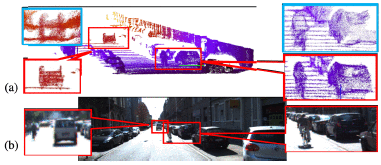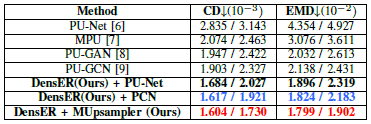DensER: Density-imbalance-Eased Representation for LiDAR-based Whole Scene Upsampling
Abstract
With the development of depth sensors, 3D point cloud upsampling that generates a high-resolution point cloud given a sparse input becomes emergent. However, many previous works focused on single 3D object reconstruction and refinement. Although a few recent works began to discuss 3D structure refine-ment for a more complex scene, they do not target LiDAR-based point clouds, which have density imbalance issues from near to far. This paper proposed DensER, a Density-imbalance-Eased regional Representation. Notably, to learn robust representations and model local geometry under imbalance point density, we designed density-aware multiple receptive fields to extract the regional features. Moreover, founded on the patch reoccurrence property of a nature scene, we proposed a density-aided attentive module to enrich the extracted features of point-sparse areas by referring to other non-local regions. Finally, by coupling with novel manifold-based upsamplers, DensER shows the ability to super-resolve LiDAR-based whole-scene point clouds. The exper-imental results show DensER outperforms related works both in qualitative and quantitative evaluation. We also demonstrate that the enhanced point clouds can improve downstream tasks such as 3D object detection and depth completion.
Contributions
- A novel framework, DensER plus MUpsampler, is proposed to conduct LiDAR-based whole scene upsampling. To the best of our knowledge, this might be an early research work that concentrates on learning local manifold representation and arbitrary scale upsampling suitable for imbalanced point cloud superresolution.
- Our feature extractor is compatible with other decoder-based upsamplers such as PCN and PU-Net. With the proposed regional representation, the upsamplers can precisely enhance the resolution of LiDAR-based point clouds with few artifacts.
- We proposed a novel region-wise objective for training, which eventually leads to a locally smooth and detail-preserved result.
- Our enhanced point clouds can significantly improve the other downstream tasks such as 3D object detection and depth completion. The corresponding results are presented as well to prove the feasibility and practicality.

(a) Point cloud upsampled by denser (red box) and compared with pugcn (blue box). (b) The corresponding rgb image and crops.
Proposed Method

The overall structure of our proposed denser and manifold-based upsampler (mupsampler).
Experimental Results

Quantitative comparison on carla/kitti dataset. Numbers in red and blue indicate the best and second-best performance.

Downstream task: 3d object detection on kitti validation dataset.

Downstream task: depth completion on kitti dataset.
Conclusion
This work proposed a Density-imbalance-Eased Represen-tation and a manifold-based upsampler to upsample LiDAR-based point cloud. To address the density imbalance issue, it performs density-adaptive multiple receptive fields followed by a density-aided attentive module to explore a more robust regional geometrical feature. The upsampler can continuously model the local surface and support upsampling on any scale. The experimental results also demonstrate that our DensER is compatible with other decoder-based upsamplers and outper-forms the other point cloud upsample networks.